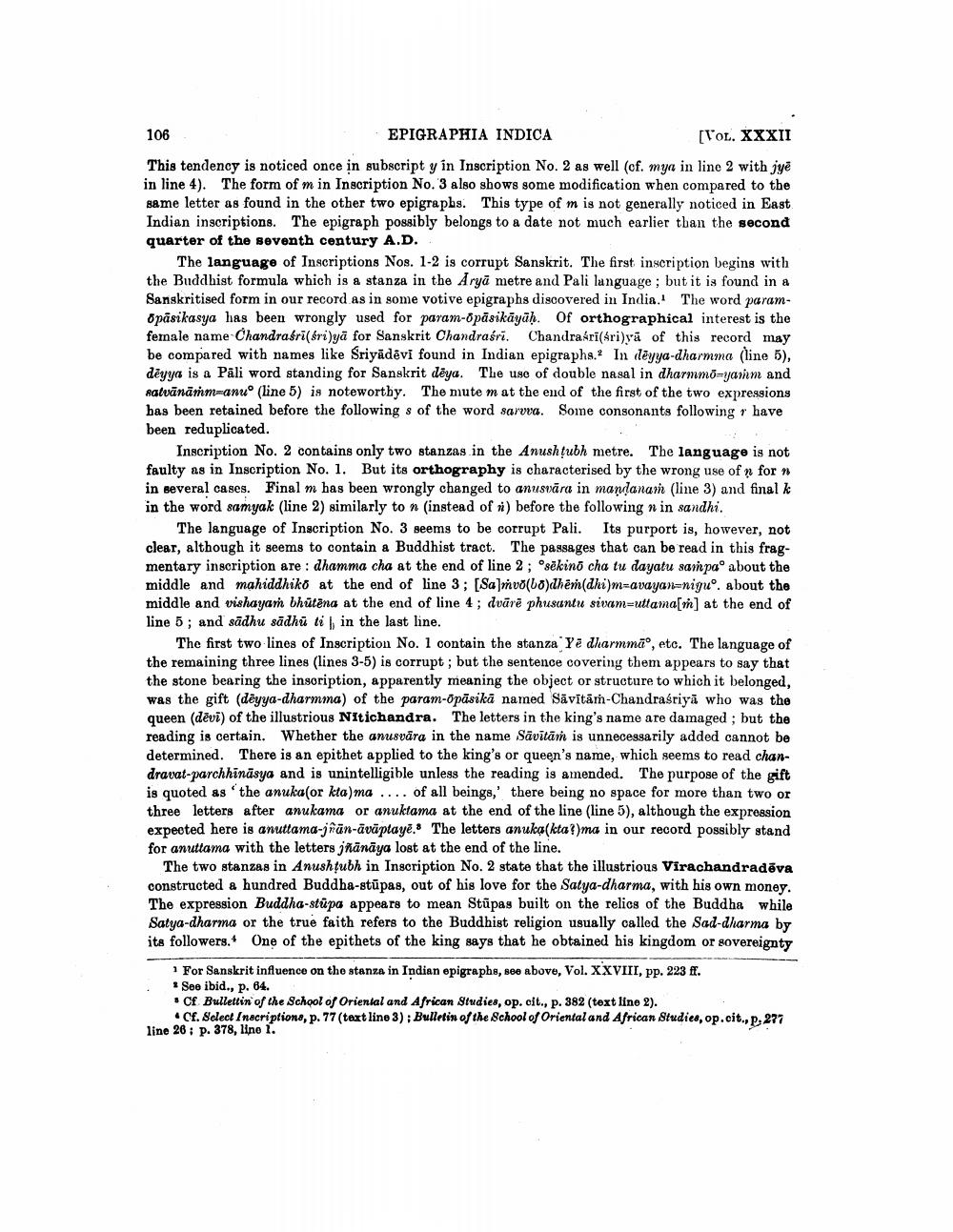________________
106
EPIGRAPHIA INDICA
[VOL. XXXII This tendency is noticed once in subscript y in Inscription No. 2 as well (cf. mya in line 2 with jyë in line 4). The form of min Inscription No. 3 also shows some modification when compared to the same letter as found in the other two epigraphs. This type of m is not generally noticed in East Indian inscriptions. The epigraph possibly belongs to a date not much earlier than the second quarter of the seventh century A.D.
The language of Inscriptions Nos. 1-2 is corrupt Sanskrit. The first inscription begins with the Buddhist formula which is a stanza in the Aryā metre and Pali language; but it is found in a Sanskritised form in our record as in some votive epigraphs discovered in India. The word paramOpásikasya has been wrongly used for param-8pāsikāyāḥ. Of orthographical interest is the fernale name Chandrasri(&ri)ya for Sanskrit Chandrasri. Chandrasri(Gri)yā of this record may be compared with names like Sriyādēvi found in Indian epigraphs. In ilēyya-dharmma (line 5), deyya is a Pāli word standing for Sanskrit dēya. The use of double nasal in dharmmojarim and natvānāṁm-anu (line 5) is noteworthy. The mute m at the end of the first of the two expressions has been retained before the following s of the word sarvoa. Some consonants following have been reduplicated.
Inscription No. 2 contains only two stanzas in the Anushtubh metre. The language is not faulty as in Inscription No. 1. But its orthography is characterised by the wrong use of forn in several cases. Final m has been wrongly changed to anusvāra in mandanari (line 3) and final k in the word samyak (line 2) similarly to n (instead of ii) before the following n in sandhi.
The language of Inscription No. 3 seems to be corrupt Pali. Its purport is, however, not clear, although it seems to contain a Buddhist tract. The passages that can be read in this fragmentary inscription are : dhamma cha at the end of line 2; "sēkino cha tu dayatu sampao about the middle and mahiddhiko at the end of line 3; [Salmvõ(lo)dhēm(dhi)m-avayan-niguo. about the middle and vishayam bhūtēna at the end of line 4; dvāre phusantu sivam=utlama[m] at the end of line 5; and sādhu sādhū til in the last line.
The first two lines of Inscription No. 1 contain the stanza ya dharmmā°, etc. The language of the remaining three lines (lines 3-5) is corrupt; but the sentence covering them appears to say that the stone bearing the insoription, apparently meaning the object or structure to which it belonged, was the gift (deyya-dharmma) of the param-opāsikā named Sävītāṁ-Chandrasriyā who was the queen (dēvi) of the illustrious Nitichandra. The letters in the king's name are damaged: but the reading is certain. Whether the anusvāra in the name Sāvītām is unnecessarily added cannot be determined. There is an epithet applied to the king's or queen's name, which seems to read chandravat-parchhīnāsya and is unintelligible unless the reading is amended. The purpose of the gift is quoted as the anuka(or kta) ma .... of all beings,' there being no space for more than two or three letters after anukama or anuktama at the end of the line (line 5), although the expression expected here is anuttama-iran-āvāptayē. The letters anuka(kta?)ma in our record possibly stand for anrıttama with the letters jñānāya lost at the end of the line.
The two stanzas in Anushțubh in Inscription No. 2 state that the illustrious Virachandradēva constructed a hundred Buddha-stūpas, out of his love for the Satya-dharma, with his own money. The expression Buddha-stupa appears to mean Stūpas built on the relics of the Buddha while Satya-dharma or the true faith refers to the Buddhist religion usually called the Sad-dharma by its followers. One of the epithets of the king says that he obtained his kingdom or sovereignty
1 For Sanskrit influence on the stanza in Indian epigraphs, see above, Vol. XXVIII, pp. 223 ff.
See ibid., p. 64. * Cf Bullettin of the School of Oriental and African Studies, op. cit., p. 382 (text line 2).
Cf. Select Inscriptions, p. 77 (text line 3) : Bulletin of the School of Oriental and African Studies, op.cit., p. 277 line 26 : p. 378, line 1.




